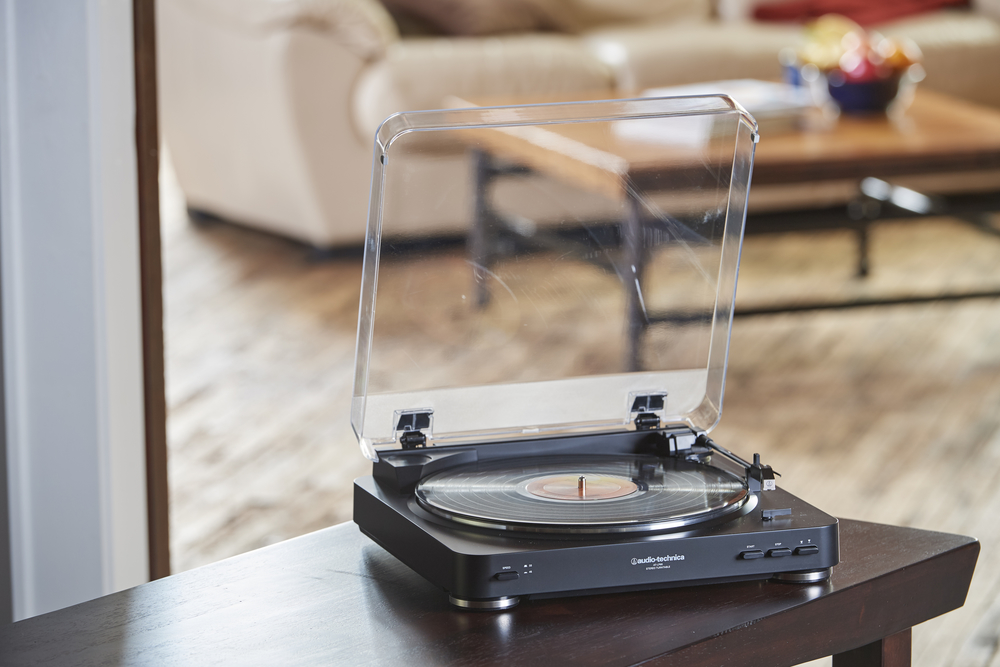Today we’ll be reviewing the Audio Technica AT-LP60 Turntable which is truly one of the best budget turntables available. We’ll be explaining how the internal preamp works, how and when to bypass the preamp and show you different setup options based on your particular situation or budget to get the best listening experience possible.
And since this turntable won’t be the perfect choice for everyone, we’ll discuss why it might make sense to go with a different option.
Regular Price – $99
Check Current Price and Any Promotions or Discounts
WHAT’S INCLUDED
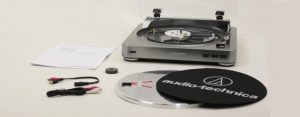 Besides the AT-LP60 record player, you’ll also get a dual RCA female to 3.5mm (⅛”) mini male stereo adapter cable, a dual RCA female to 3.5mm (⅛”) mini female stereo adapter cable, a 45 rpm adapter, a manual and it comes with a limited 1-year warranty.
Besides the AT-LP60 record player, you’ll also get a dual RCA female to 3.5mm (⅛”) mini male stereo adapter cable, a dual RCA female to 3.5mm (⅛”) mini female stereo adapter cable, a 45 rpm adapter, a manual and it comes with a limited 1-year warranty.
DESIGN AND FEATURES
Size wise this turntable is 14in (36cm) square by 3.8in (10cm) high and weighs 6.6 lbs (3 kg). So it’s actually pretty light-weight and easy to move around or relocate as needed.
The AT-LP60 is a belt-driven turntable, which means the platter (the thing your record sits on) is spun by using a rubber belt. So as a side-note, this type of system is not good for DJ use.
BELT-DRIVE VS DIRECT-DRIVE
If you start looking into whether a belt-drive or direct-drive turntable is better, you’ll come to find that there are some very distinct opinions as to which one people prefer.
Generally speaking, the idea is that a direct drive provides better speed-accuracy (because of driving the platter directly), while the strength of the belt drive is that it does a better job isolating records and cartridges from motor noise and vibration.
But the thing to keep in mind is that at this price point (and even up to $300), neither one offers a real clear advantage over the other.
FRONT OF UNIT BUTTONS AND OPERATION
There are 4 buttons located at the front of the unit. Beginning at the left side you have the ‘speed’ button. There are two speeds to choose from (33 ⅓ and 45). So depending on the record you’re playing, you’ll want to select the correct speed to play that record at. Otherwise it will sound too fast or slow.
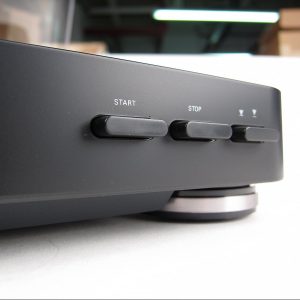
On the right side you have the ‘Start’ button. This is what you press to start playing a record. What’s great is everything is automatic so as soon as you hit the ‘start’ button it raises the arm for you. It’s super convenient and easy to use as you don’t have to ever worry about doing that yourself. You just hit the button and it takes care of the rest.
The ‘Stop’ button does the opposite, it just stops everything. It stops the record and puts the arm back into place. So everything goes back to the ‘ready to start’ position.
The button on the very far right is the one you press to raise and lower the arm. If you hit this button it’s like hitting the ‘pause’ button. So if you’re playing a record and you want to stop or pause it for a bit, just hit this button.
Basically it will keep the platter spinning after it raises the arm, effective ‘pausing’ the music for you. Then when you’re ready to resume playing, hit the button again and the arm will lower again taking you to right back to the same place you were at (or listening to).
BACK OF UNIT
At the back of the unit there is a power cord which you’ll of course want to plug into a power outlet.
Component cables are provided which allow you to connect this to something like a preamp, speaker system or powered speakers.
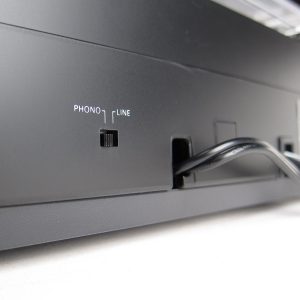 There is an option to select either ‘phono’ or ‘line-in’ which will depend on what you’re connecting to. The phono connection is used when you want to bypass the internal preamp.
There is an option to select either ‘phono’ or ‘line-in’ which will depend on what you’re connecting to. The phono connection is used when you want to bypass the internal preamp.
Typically you’d select this anytime you’re connecting to an external preamp or stereo system (in which case you’ll be using the component cables). Again, for this type of connection you’ll be bypassing the Audio Technica’s internal pre-amp and using an external pre-amp.
The line-in option would be used if you wanted to connect this to something like an iPod dock or powered speakers. For the line-in connection, they do provide you with a cable adapter which you would connect to the ends of the component cables.
Then you’re able to connect to something like powered speakers or a soundbar via an auxiliary cord. The line-in connection uses the internal pre-amp that’s already built-in to this turntable.
If you end up getting the USB version of this turntable, then you will also have the ability to connect this record player using a USB connection. This allows you to transfer your vinyls over to digital files, which is a really cool feature if you think you’ll need that. Some people who do this actually prefer the digital vinyl recordings of their albums compared to the CD or MP3 versions.
SOUND QUALITY
The sound quality is very good considering what you’re paying for this. There’s good channel separation and it’s able to present a quiet background with nice vocal clarity. However, during more detailed musical sections on the inner grooves of your records, you may notice some imperfections surface here. But this isn’t uncommon for any turntable in this price range.
Overall, the sound is very pleasing to listen to, not harsh and this will give you a good listening experience as long as you have this paired with a decent set of powered speakers or a decent stereo system.
REASONS TO CONSIDER UPGRADING
Although this unit is very competent on it’s own, there are a few reasons you may want to upgrade to something nicer.
First, if you think you’ll want to convert any of your vinyl albums to digital files that you could play on your computer, phone, etc. then you’ll want to get the USB version. Aside from allowing you to make a USB connection to your computer, there aren’t any other differences between this and the AT-LP60. So certainly a great feature to have if you think you’ll use it, but otherwise there’s no need to spend the additional money.
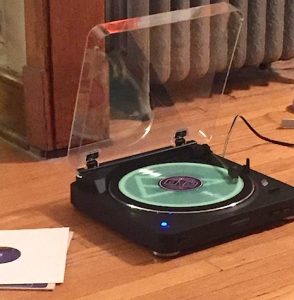
Next, if you want the flexibility to be able to change the cartridge out then you may want to look into a different option. Changing the cartridge allows you to upgrade to something nicer which would increase the potential sound quality. But otherwise, the included cartridge is actually quite good and is even included in many other record players (even one costing $1,000).
Also, If you like the idea of being able to stream your music via Bluetooth to a compatible speaker, computer, stereo system, etc. then you may want to consider the Audio Technica LP60-BT.
It functions exactly the same as the AT-LP60, except it also has the ability to connect to Bluetooth enabled devices when playing your records.
But otherwise, if none of these reasons really make a difference for you now, then that’s just additional confirmation that the AT-LP60 is really the best model for you and there’s no reason to feel like you should spend more money.
SETUP
One of the most common questions when purchasing a turntable like the AT-LP60 often seems to be, “is there anything else I need to purchase to use this, like speakers?” And the answer to that is that it depends on what you already have.
So here are the different ways you can set this up and start using it right away, and if you don’t already have a good option ready to go, then we’ll make a few recommendations for you to consider as well.
But one of the great things about this turntable is how easy it is to get setup for use. Audio Technica created a simple and straightforward video showing you exactly how to get everything ready once you unbox it.
AT-LP60 Complete Setup Video
As a side note, if you are not a fan of the “Audio Technica” wording/logo being shown on the included felt mat, just flip it over for a plain look instead.
Now once your record player is setup, the next step in order to actually hear the music that’s being played by this record player, is that you will need to hook this up to either powered speakers or a stereo system.
And this is where there can be some confusion here. So we’ll discuss the different options and then you can decide if you already have something that will work, or if you’ll need to purchase anything else.
USING THE INTERNAL PRE-AMP WITH POWERED SPEAKERS
The first configuration you can use is to take advantage of the internal preamp that’s included internally with this turntable. With other turntables you may have to purchase a pre-amp separately, but the AT-LP60 has one built in. It’s a real plus as this makes for a hassle-free setup.
As a result, you are able to connect directly to powered speakers without the need to purchase a separate preamp. So if you already have powered speakers (or are planning on purchasing those) then you can connect the AT-LP60 directly to these speakers and you’ll have everything you need in order to listen to your music.
But if you don’t have any speakers to connect to this to yet, or the ones you have are really cheap quality and you’re thinking of upgrading to something better, then a pair of powered bookshelf speakers by Edifier would be the perfect ones to get.
For the money, they’re the best powered bookshelf sized speakers at this price point and they will allow you to take advantage of the full sound quality that this record player is capable of.
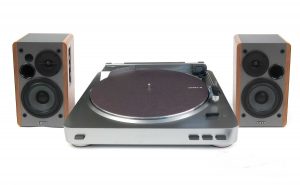 A good rule of thumb is to pair this record player with powered speakers that are around the same price point or better. Otherwise you may not be getting as much sound quality as you could with better quality speakers.
A good rule of thumb is to pair this record player with powered speakers that are around the same price point or better. Otherwise you may not be getting as much sound quality as you could with better quality speakers.
For example, if you were to pair this with a pair of $25 powered speakers, although you’d be able to hear your music this way, and technically that would work just fine. But you’d be missing out on some of the additional detail and clarity that better quality speakers would produce.
So if you decide to go with this setup option, then you’ll want to make sure that “line-in” is selected at the back of the unit. After that you’ll want to use the included adapter cables which will allow you to connect this turntable to the powered speakers you’ll be using.
After you do that, you are all set! Just make sure your powered speakers are turned on and you have the volume at the appropriate level. Then once you hit the “start” button on the front of the turntable you’ll start hearing your music playing.
And one final thing to keep in mind is that the volume will be adjusted through your powered speakers only, as there is no volume adjustment on the turntable.
BYPASSING THE PREAMP
The other option is to bypass using the internal preamp of the AT-LP60. This means you’ll be connecting directly to a receiver or amplifier that has an internal preamp designed for turntables.
If you go this route, it will allow you to use your AT-LP60 with a compatible receiver, amplifier or pre-amplifier. If you already have a receiver/amplifier, you’ll need to check that it has a phono preamp connection (which is not a given considering that most modern receivers lack this).
But if your receiver/amplifier has one, it should be located at the back of the unit.
Another choice is that you can connect your turntable to an external stand alone preamp. ART makes an affordable phono turntable preamplifier that is ideal for this type of situation. And if you go this route, you’ll get noticeably better sound quality.
Either way, if you decide to bypass the preamp for your setup, then you’ll want to select the “phono” option which is located at the back of the turntable. This effectively tells your record player that you don’t want to use it’s internal pre-amp and that it will instead be using preamp of the receiver/amplifier/preamp you’ll be connecting it to.
PROS AND CONS OF THE DIFFERENT SETUP OPTIONS
Your situation and budget will have a lot to do with which setup is best for you. As you can see, there is more than one way to setup your turntable so that it can start playing music.
The benefit of using a separate preamplifier (not the internal one that’s part of the turntable) is that you’ll get a better quality listening experience (and noticeably so). The downside though is that you may have an additional expense if you need to purchase an additional component to make this work.
The benefit of using the internal preamp that’s built into the AT-LP60 is simplicity. All you need is a pair of powered speakers to connect to and you’re good to go. This also works better for portable use as it becomes something you could bring to a party or event.
And from a minimalist standpoint, this setup requires the least amount of space so it’s ideal if that is a consideration as well.
ADDITIONAL RECOMMENDATIONS TO CONSIDER
So hopefully you have a good understanding now of the different options you can use to make sure your AT-LP60 turntable is ready to play music.
If you don’t already have everything you need to be able to enjoy listening to music with your turntable, here’s a few options I’d recommend:
1. Edifier R1280T Powered Speakers
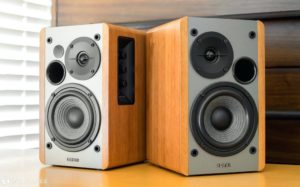
If you want to go with the setup that requires the least amount of additional things to get, then you’ll want to go with a pair of powered speakers. Otherwise, without speakers to hear your music through, your records will just spin there silently (as the AT-LP60 doesn’t have any built-in speakers).
But if those speakers are a little out of your price range, or if you’d like something with a smaller profile then you’d want to go with the Edifier R980T 4″ Active Bookshelf Speakers.
These are still an excellent choice and they’re still powered speakers. They just don’t get as loud or have the same level of detail, clarity and low-end oomph that you’d get with the Edifier R1280T speakers.
2. ART DJPRE II Phono Turntable Preamplifier
If you’d like to get a noticeable bump in the sound quality from your turntable, and not have to spend a lot or invest in larger pieces of audio equipment to do so, then this phono turntable preamp by ART is the way to go.
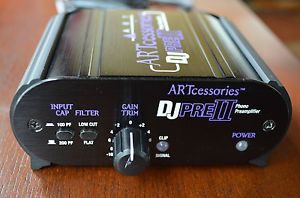 How this works is you’ll be connecting your turntable to this amp (be sure to select ‘phono’) and then you’ll connect the ART preamp to your powered speakers. This allows you to bypass the built-in preamp of the AT-LP60 and as a result, everything sounds noticeably better.
How this works is you’ll be connecting your turntable to this amp (be sure to select ‘phono’) and then you’ll connect the ART preamp to your powered speakers. This allows you to bypass the built-in preamp of the AT-LP60 and as a result, everything sounds noticeably better.
Also you could also use this ART preamp if you have a receiver that doesn’t have a phono input. That way you don’t have to go and purchase another receiver, you can instead just connect the ART preamp to the receiver and that will work just fine (as long as you have at least one set of available inputs to use on your receiver).
And finally, another option is if you have a soundbar and want to use that as the speaker for your turntable. You could use this ART preamp as a way to connect your AT-LP60 to your soundbar as well.
3. Onkyo TX-8220 2 Channel Stereo Receiver (with Bluetooth)
If you’d like to invest in a receiver which allows you to connect other devices such as a Bluray player, video game consoles, etc. then this 2-channel receiver by Onkyo is an excellent choice. You’re getting good quality components (so everything will sound and work well), and it has a phono input which is designed to work with turntables such as the AT-LP60.
Just keep in mind that this receiver only supports 2-channels, so it will only allow you to have a total of two speakers connected to this receiver.
So if you’d like something that would allow you to have a home theater setup (and connect to multiple speakers) then the Yamaha RX-V683BL 7.2-Channel AV Receiver (works w/ Alexa) would be an excellent choice.
It also has a phono input designed for turntables and it has several speaker connections so that you can have the full home theater surround sound experience (including up to two subwoofers).
You can even just start with just a pair of speakers and then add more as your budget allows. For example, you could start with the Pioneer bookshelf speakers that are mentioned next, then when you can afford to get another pair of speakers you could move the bookshelf speakers to the rear (you want the best sounding speakers in the front).
4. Pioneer SP-BS22-LR Bookshelf Speakers
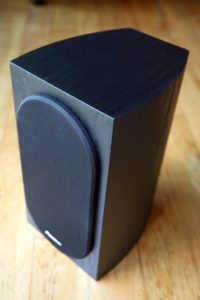 If you decide to invest in a receiver, then you’ll also need a pair of speakers to go with it. These Pioneer speakers designed by Andrew Jones are the best speakers you’ll be able to find at this price point.
If you decide to invest in a receiver, then you’ll also need a pair of speakers to go with it. These Pioneer speakers designed by Andrew Jones are the best speakers you’ll be able to find at this price point.
If you’d prefer something that doesn’t cost as much or that is a smaller profile then you’d want to go with the Edifier P12 Passive Bookshelf Speakers or the Micca MB42 Bookshelf Speakers.
You can’t go wrong with either one and it just comes down to how much you have to spend as well as whether you want the speakers to take up the least amount of space possible. These are both “passive” speakers (as opposed to being “active”) which means they do require an amplifier/receiver to work.
Just be sure to get a good basic speaker wire if you don’t already have some. A 16-gauge speaker wire would be the perfect size for either of these speakers.
The gauge refers to the size or diameter of the speaker wire. The smaller the number the larger the diameter (kind of confusing, I know). So again, a 16-gauge speaker wire would be just right.
BOTTOM LINE
So whatever configuration you decide to go with, the bottom line is that the AT-LP60 is literally the easiest record player to use ever.
For an entry level record player, you can’t beat the performance and price of this. It’s light, durable and the fact that there’s a preamp built in makes this a very practical record player to own. The sound quality is good and it can sound amazing when you connect this to quality components (such as the ones listed above).
This turntable is designed to allow people to enjoy listening to vinyl without having to spend a fortune. And for those who want to improve or boost the sound quality as they go along, there’s certainly some things you can do to get the maximum sound quality possible from this such as the utilizing some of the different setup options above.
So for anyone just getting into vinyl or someone who has some records they’d like to be able to listen to without spending a fortune, this is really the way to go.
Check Current Price and Any Promotions or Discounts for Audio Technica AT-LP60

